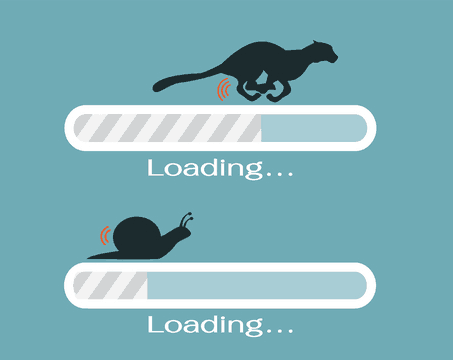If you suspect your website loading times need improvement, there’s a decent chance you’re right. The bad news is that Google thinks pages should load in two seconds, which is a mark few websites hit. The good news is we’re going to show you effective tricks to speed up your website’s loading times.
While you should be worried about poor user experience due to your slow loading website, another concern is that Google might decide your website is underperforming if it’s too slow and hit you where it hurts — search engine results.
The average load time for a webpage is 8.66 seconds, which is longer than many visitors want to wait. That might make Google’s goal of an internet-wide two-second load time seem impossible, but the search engine is serious about it and you should be, too. But what is a good page load time? Ideally, it should be around 0-2 seconds, with up to 3 seconds still considered acceptable. Any longer, and you risk visitors clicking away and leaving your website.
With more people accessing the internet via mobile devices than desktops or laptops, Google has switched to emphasizing a website’s mobile version load speed in its algorithms. In January 2018, the company announced its “speed update,” which went into effect in July and rewards faster loading websites with better search rankings.
Before Anything, Check Page Load Time Speed
You don’t need to guess how fast your website load time when it’s simple to find out. Go to Pingdom, type your web address into the URL box, select a test location and hit the “start test” button. In about 30 seconds, you’ll get the performance information you need in an easy-to-read format. Don’t despair if it’s not impressive yet. We’ll help you get there.
How to Improve Page Load Time: Page Load Time Best Practices

It’s okay if you’re not a coding beast. The following tips don’t require special technical skills beyond those you likely already have. If you’ve managed to get a website online, you know enough to apply these speed improvements. Let’s see how to improve webpage load time.
Design for Fewer HTTP Requests
Each element on a webpage — images, stylesheets, scripts — requires a visitor’s browser to send a request to the server to receive files for display. That should happen fast. When it doesn’t, the problem could be that your website design generates so many HTTP server requests that it slows page loading time.
Try simplifying the design by cutting non-essential elements. Keep only those needed for what you’re trying to accomplish, whether that’s collecting email addresses or making sales. People rarely visit a website to be awed by bells, whistles and shiny things. They want to do something and you should make it easy for them.
Introducing Content Delivery Networks
Things should happen fast online, but lag increases as physical distance does (much like it will with a virtual private network). If a browser in Berlin asks for website files from a server in Dallas, there will be a slower load time compared to the same request from nearby Fort Worth.
The content delivery network concept came from the realization that replicating website files across a global network would improve loading times.
A CDN is a subscription service that works with your regular web host by caching a copy of your website on a network of far-flung servers. When the host server receives a view request, it locates and notifies the CDN network server closest to the request.
Given how fast visitors abandon a slow website, it may be wise to pay to use a CDN. Well-known brands include CloudFlare and MaxCDN, with providers typically charging by the month based on the amount of bandwidth used to deliver your website. Excellent web hosting services provide CDN, usually CloudFlare.
Self-Hosted Videos are a Bandwidth Destroyer
Images use a lot of bandwidth but video takes more. If you’re relying on allotted computing resources on a shared server — a popular choice for many first-timers because it’s cheap — be aware that you can burn through your share fast, resulting in poor website performance and lost visitors.
That’s where third-party services such as YouTube or Vimeo come in. Upload your videos to one of those websites, then embed links to them on yours. Storing videos on your host server wastes precious online resources, so avoid doing so when you can.
Optimize, Minimize, Compress

Like most of us, the internet obeys the laws of physics. That means larger files take longer to transfer from server to browser and use more bandwidth doing it, which also causes slow page loading. Since bandwidth is a finite resource, it makes sense to reduce file size where you can. Here are three methods to do so.
Optimize Images
Next to video, images use the most bandwidth, which is another cause of slow website load times. Reduce file size with a third-party graphics program, such as Photoshop or the free version of Pixlr, before uploading them to your website.
While a content management system, such as WordPress, offers the illusion that you can save space by cropping or adjusting resolution in the dashboard area, don’t be fooled. You’re still working from a full-size image on the server.
Minimize CSS
A cascading stylesheet is an external file that applies design elements, such as font and color control, to the HTML code. The problem is that it often contains unnecessary white space that looks good to human eyes, but is irrelevant to computers. Run CSS through a free service such as CSS Minifier to get a smaller file.
Compress Website Files
Compressing website files into the Gzip format can save as much as 70 percent of file size. Gzip may already be enabled on your website, so check to see if it is first. If it’s not, WordPress plugins such as WP Rocket or W3 Total Cache can do the zipping. Static websites need to have code added to the .htaccess file, which these detailed instructions can help you with.
Final Thoughts
With the demand for interactivity growing stronger, expect file bloat to continue to push toward longer load times. The best strategy to fend it off is regular speed testing. You should also expect your mission to reach and maintain that two-second load time Google demands will be an ongoing process.
Looking for more tips on how to improve your website? Have a look at our articles on how to make a website for a business, as well as how to host a website. We also share our favorite web hosting services for small business. Make sure to check it out.
If you have tips or tricks to share about website loading speed, let us know in the comments below. Thanks for reading.
The post How to Improve Website Loading Times: 6 Easy Tips appeared first on Cloudwards.

